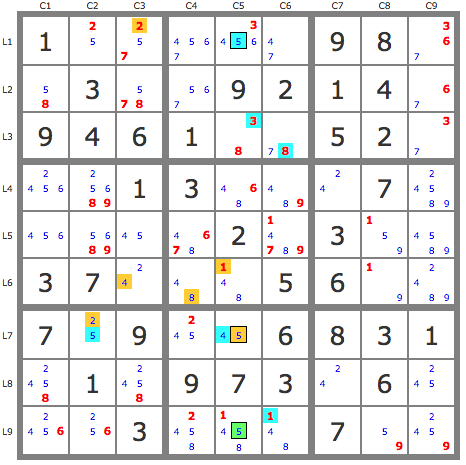StrmCkr wrote:Kraken examines what is happening on the puzzle by assuming that all occurrences of the same area (row, column or block) are valid in turn.
Thats is false
What exactly is false in that? It's what krakens do, although Robert offers a bit limited view of them. A kraken can be formed of any strong inference set (SIS), not just the native digit-rows, digit-columns, digit-boxes, or cells (which weren't mentioned). For example, all guardians of a deadly pattern are a SIS, and their combined logic is usually presented as a kraken. The same with a multi-finned fish with indirect implications, where the "kraken" term probably originated.
Basically a kraken is a chain representation of a case-by-case analysis of a set of candidates and their implications, where it's guaranteed that at least one member in the set must be true (SIS). Thus if all members of the set can agree on some implication, that implication must be true. A SIS is just an extension of a binary strong link to include multiple strongly linked options that all must be accounted for, and a kraken is a way to present their implications as chains. Nothing more complicated than that.
They are written that way for clear consice way of presenting complicated aic chains using logic gates ot very complicated set logic.
Basic krakens are actually fairly simple. They're just AICs with multiple end points. As long as the branching chains are linear, i.e. they're trees instead of graphs, I wouldn't call it "very complicated logic" (unless it's a multi-kraken). In terms of set logic basic krakens (and even multi-krakens) don't have triplets which are responsible for most real complexity. If those are needed, then we have a net, which may or may not use kraken logic.
With out manipulating the grid physically.
I don't know what that has to do with anything. It doesn't matter how the case-by-case analysis is actually performed as long as it covers all cases and finds the common implications. It makes no difference whether it's done by eye-balling, or coloring, or running actual trials on a separate or a saved grid. In fact, most krakens are probably found as contradictions and then reversed for a nicer presentation.
Almost all of the krakens I use directly are based on deadly patterns or finned fishes or other almost-patterns. I don't think I've ever started with a basic row, column, box, or cell with multiple options to look for where they lead -- mostly because it's rarely necessary and because it's tedious to do manually. My usual coloring method only works with binary strong links, and testing multiple options at the same time requires other tricks, so I only do it with interesting SIS.
Btw,
here's a nice example of a multi-kraken, by totuan. It uses six three-way krakens in the same piece of logic. It also includes two link triplets. I'd really love to know how he does that manually. Hodoku can't find that net.


